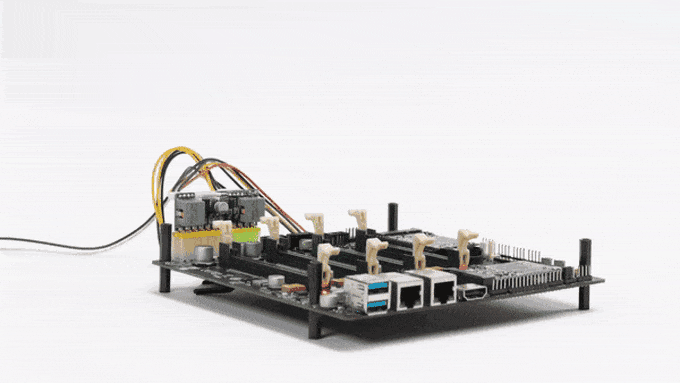Turing Pi 2 mini-ITX cluster board supports RK3588 based Turing RK1, Raspberry Pi CM4, and NVIDIA Jetson SoMs
If there aren't enough options, the company also unveiled its own eight-core system-on-module with 6 TOPS NPU and up to 32GB of RAM.
Turing Machines has launched a crowdfunding campaign for their second-generation Turing Pi 2 cluster kit, and it has already surpassed its financial target within three minutes of coming live.
Turing Machines rose to prominence three years ago with the introduction of the Turing Pi Clusterboard, a carrier for up to seven Raspberry Pi Compute Module 3/3+ systems-on-modules (SOMs) designed to fit within a mini-ITX housing and provide an affordable and accessible platform for cluster computing and home-lab projects. The Turing Pi 2 was announced in October 2020, and it replaces the seven CM3/3+ modules with four more powerful Raspberry Pi Compute Module 4 boards, as well as introduces additional capabilities like support for SATA storage devices.
However, the electronics industry hasn't been kind to the company in recent years, and while the company had hoped to launch the new board in 2021, it's only just managed to launch the crowdfunding campaign — to what appears to be huge pent-up demand, easily exceeding its funding goal in the first three minutes.
The Turing Pi 2 is an amazingly flexible carrier board for up to four Raspberry Pi Compute Module 4s, just as it promised: Two SATA-III storage ports, two mini-PCI Express (mPCIe) slots, one HDMI and one DSI output for external displays, two Ethernet ports linked to an L2 managed switch with VLAN support, three USB 3.0 ports, an on-board real-time clock, baseboard management controller, and a single 40-pin general-purpose input/output (GPIO) header are all included.
Turing Pi 2 specifications:
- SoM
interface – 4x 260-pin SO-DIMM slots for up to four
- Raspberry
Pi CM4 with Broadcom quad-core Cortex-A72 processor, up to 8GB RAM, up to
32GB eMMC flash (adapter needed)
- NVIDIA Jetson
Nano/TX2
NX/Xavier
NX SO-DIMM system-on-modules with up to 6x Armv8 cores, and 16GB
RAM.
- Turing
RK1 with Rockchip
RK3588 octa-core Cortex-A76/A55 processor, up to 32GB RAM, eMMC
flash
- Storage
– 2x SATA III ports via a PCIe controller connected to one module
- Video
Output – 1x HDMI port, 1x MIPI DSI header
- Audio
– Digital audio via HDMI
- Network
connectivity
- 2x
Gigabit Ethernet RJ45 ports
- 1
Gbps 7-port L2 managed switch with IEEE802.1Q VLAN for the two RJ45
ports, four Gigabit Ethernet interfaces between the modules, and 100Mbps
for the BMC
- USB –
2x USB 3.0 Type-A ports, 2x USB 3.0 via header
- Expansion
- 2x
mPCIe sockets, each connected to a specific module, including one with a
SIM card socket
- I2C
header for cluster management
- 40-pin
GPIO header
- Misc –
RTC + coin-cell battery holder, system fan connector, front panel header,
Board Management Controller (BMC) with remote access
- Power
Supply – 24-pin ATX header
- Power
Consumption – Less than 60W with four NVIDIA modules
- Dimensions – 170 x 170 mm (Mini-ITX form factor)
The Turing Pi 2 isn't restricted to the Raspberry Pi family, despite its name: The carrier board also supports the Turing Pi RK1, an in-house system-on-module created by Turing Machines. The RK1 is based on the Rockchip RK3588 and is intended for uses where the Raspberry Pi would be inadequate: Four Arm Cortex-A76 and four Arm Cortex-A55 processor cores, a neural processing unit (NPU) coprocessor with a claimed 6 TOPS of computing performance, a second-generation video processing unit (VPU) with 8k support, and up to 32GB of RAM — four times the maximum available on the Raspberry Pi — are among the features.
If that wasn't enough, the NVIDIA Jetson Nano, Jetson TX2 NX, and Jetson Xavier NX modules, built for highly parallel workloads like computer vision and robotics, are also supported by the carrier.
The modules can be deployed in any configuration until all four slots are filled in a cluster designed for mixed workloads. Meanwhile, the management controller offers remote access as well as quick bootstrapping to OS images and Kubernetes deployments, as well as over-the-air update capabilities, according to the business.
Physical incentives start at $199 for a single Turing Pi 2 Cluster Board at Super Early Bird pricing, increasing to $209 for Early Bird supporters until settling at $219 — a $20 reduction from the board's ultimate selling price, according to the business — with delivery for all tiers slated for September. The SOMs, on the other hand, are not included and must be purchased individually.

















0 Comments